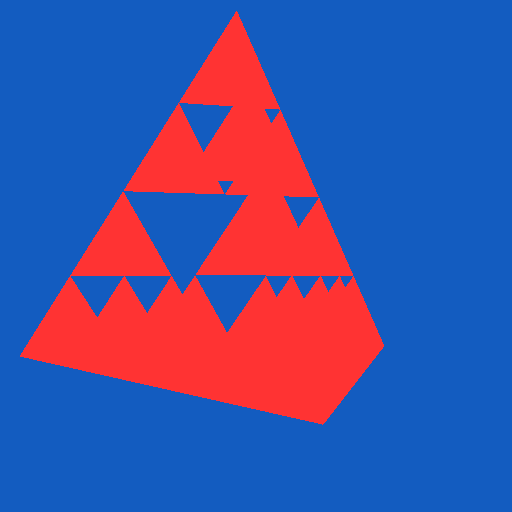CMSC 435/634: Introduction to Computer Graphics
Assignment 1
Ray Tracing
Initial submission September 11, 2015
Due September 16, 2015
Before you start
You will be doing your work this semester in a class git repository. Before you get started on any of the assignments, you should fetch yourself a copy of your personal repository following these directions. Your personal class respoitory on the UMBC GL/Linux systems is /afs/umbc.edu/users/a/d/adamb/pub/435/your-user-name.git
To make sure you do not have last-minute problems, you must commit
and push something to your repository by Friday, September
11th. This be anything from an update to the readme to the completed
project.
The Assignment
For this assignment, you must write a C or C++ program that will render triangles using ray tracing and the barycentric coordinate intersection method. The input is in a simple text format called NFF, containing information about the view and objects in the scene. You will read an NFF scene from a file or stdin, and ray trace the single image described there. Rays that hit an object should be rendered in the triangle color, while rays that do not hit any object should use the background color of the scene. Do not try to include any of the more advanced ray tracing features you may read about (shadows, reflection, refraction, lights, etc.), we will get to those in the next assignment. Your output should be an image file in PPM format.
You can run my program here:
~adamb/public/trace/trace input.nff output.ppm

Input
For the base assignment, you should be able to trace tetra-3.nff, which is checked into your assn1 directory. Additional NFF format scenes can be generated using a set of programs called the 'Standard Procedural Databases'. A copy of these programs may be found in ~adamb/public/spd3.14/. While NFF format is relatively simple, it does contain many features we will not be using in this assignment. You should be able to read any NFF format file, but ignore anything you do not implement. For the basic assignment, you should at least handle the "v" viewing specification, "b" background color, "f" object material specification (just the r g b color part, ignore the rest), and "p" polygon specification. "c" and "pp" are all multi-line, so you will at least need to recognize enough of those to know how much to skip. See here for more detail on the commands your program should support
Split any polygon with more than three vertices into a fan of triangles: given vertices 0,1,2,3,4, the triangles would be (0,1,2), (0,2,3), (0,3,4)
Since the SPD programs produce their output on stdout, if your ray tracer takes its input on stdin, you can pipe them together:
~adamb/public/spd3.14/tetra | ./trace
Since that has 4096 triangles and can be slow to raytrace, using the -s option can yield a simpler models. For example, tetra-3.nff with 64 triangles was generated with
~adamb/public/spd3.14/tetra -s 3 > tetra-3.nff
Output File Format
The PPM format is one of the simplest image formats available. See the man page
for 'ppm' on the university GL server for a description.
To create a PPM file, first you should store your image in an array of bytes in y/x/color index order:
unsigned char pixels[HEIGHT][WIDTH][3];
When filling in this array, remember that it is in y/x order, not the more familiar x/y order.
The final index is the color component, with r=0, g=1 and b=2. Color values range from 0 to 255. For
example, this would store a floating point color value of .5 into the green component at x,y:
pixels[y][x][1]= .5*255;
Once you've filled in the pixels array, actually writing the PPM file is quite simple:
FILE *f = fopen("trace.ppm","wb");
fprintf(f, "P6\n%d %d\n%d\n", WIDTH, HEIGHT, 255);
fwrite(pixels, 1, HEIGHT*WIDTH*3, f);
fclose(f);

634 only
Splitting polygons into a fan of triangles only works for convex polygons. Instead, use the test-ray method to handle arbitrary concave polygons. Try the "gears" SPD program to generate a scene with some pretty complex polygons.

Extra Credit
For up to 10 points of extra credit, implement spheres too. Try the balls SPD program for a scene with lots of spheres.
Other people's code
Ray tracing is a popular rendering technique, and the internet contains lots of resources for ray tracers in general and things like ray-object intersection in particular. Other than the PPM snippet above, YOU MAY NOT USE ANY OUTSIDE CODE. All code that you use must be your own.
Strategy
This is a big assignment. Start NOW, or you will probably not finish. No, really, I promise you will not be able to do it in the last two days. Even before we get to all of the details of the ray tracing itself, you can still start working on your file parsing.
Some implementation tips from a previous instructor.
What to turn in
Turn in this assignment electronically by pushing your source code to your class git repository by 1:00 AM on the day of the deadline. Do your development in the proj1 directory so we can find it. Be sure the Makefile will build your project when we run 'make' (or edit it so it will). Also include a README.txt file telling us about your assignment. Do not forget to tell us what (if any) help did you receive from books, web sites or people other than the instructor and TA.
Check in along the way with useful checkin messages. We will be looking at your development process, so a complete and perfectly working ray tracer submitted in a single checkin one minute before the deadline will NOT get full credit. Do be sure to check in all of your source code, Makefile, README, and updated .gitignore file, but no build files, log files, generated images, zip files, libraries, or other non-code content.
To make sure you have the submission process working, you must do at least one commit and push by the friday before the deadline.


